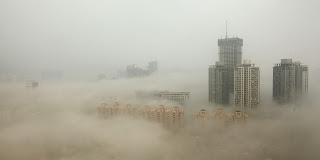In recent years China's deteriorating air quality has increasingly been suggested as a potential co-factor driving the severity of their yearly flu seasons. Particularly, but not exclusively, the effects of fine particles less than 2.5 micrometers in diameter[1].
There have already been number of studies that have found an apparent correlation between the level of air pollution and respiratory outbreaks in China[2][3].
The age groups most affected by increased dust and pollution vary by study. There is a lot we still don't know about the environmental effects on influenza.
These days, each winter - between November and December - much of the Eastern seaboard of China is plagued by heavy and persistent haze and smog. At the same time, reports of extremely heavy pediatric respiratory outbreaks appear[4]. Dozens of similar reports came in from Anhui province, Jiangsu Province and Liaoning Province.
A letter to the Editor of the American Journal of Infection Control that not only describes the extent of the outbreak in Shanghai in December, 2015, it also discusses its potential link to the Shanghai's poor air quality last winter[5]. “The epidemiologic association between the occurrence of haze and the incidence of influenza A virus infection remains largely unknown. However, during the widespread and dense haze events that occurred during the winters of both 2013 and 2015, we observed a sharp increase in the number of patients with respiratory tract infection, especially influenza A virus infections”.
The researchers pose themselves a series of questions. Is the particulate dense air inhaled into the respiratory tract during a haze event a vector for pathogens, including influenza A virus? Does heavy haze decrease the resistance of lung tissue to pathogenic microorganisms, thereby increasing the risk of respiratory disease? Does influenza A Virus merely happen to coincide with the seasonal haze?
[1] Feng et al: Impact of ambient fine particulate matter (PM2.5) exposure on the risk of influenza-like-illness: a time-series analysis in Beijing, China in Environmental Health – 2016
[2] Liang et al: PM2.5 in Beijing - temporal pattern and its association with influenza in Environmental Health – 2014
[3] Huang et al: Acute effects of air pollution on influenza-like illness in Nanjing, China: A population-based study in Chemosphere – 2016
[4] Ouyang: China wakes up to the crisis of air pollution in The Lancet – 2013
[5] Qingchun et al: Haze and influenza A virus: Coincidence or causation? in American Journal of Infection Control - 2016

No comments:
Post a Comment